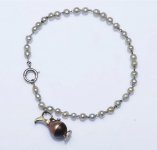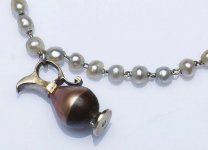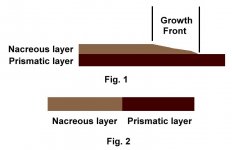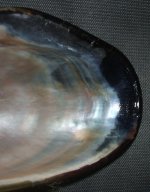BIJOUX & MONTRES said:
Bracelet en argent (925 millièmes) composé de petites perles de culture grises irrégulières et retenant un motif en pendeloque figurant une aiguière la panse composée d’un coquillage sculpté et la monture en argent (925 millièmes) sertie de diamants taillés en rose. XIXème siècle.
My French-Canadian translates this as : 925 Silver bracelet composed of small gray irregular cultured pearls and pendant motif representing a ewer, the body composed of a carved shell and a 925 silver frame set with cut pink diamonds. Nineteenth century.
I don't see pink diamonds, but perhaps it's meant as a through type diamond setting at the level of the pink/bronze nacre. Isi, can you clarify this translation?
Nevertheless, there's a lot of ambiguity in this description. First, cultural operations were not commonplace in the 19th century. Second, the nacreous and proteinaceous/prismatic surfaces of the pitcher suggest Pterioda or Pinna origin. (Black lipped oyster or pen shell). The symmetry of the piece supports cultural origin which would likely be mid 20th century. Now, if by some fluke this was natural origin, I'd observe some distinct features, namely a pronounced transitional growth front along the margin between the different surfaces. It's not the best image, but
the margin of nacre presents as gradual and inclusive as opposed to terminal and superior. In other words, features I'd expect to observe in cut shell. As such, I have my doubts it's a loose natural pearl, but concede it may be a natural blister. However slightly. It's more likely a cultural aberration.
Now interestingly enough, the description of the tiny pearls is also suspect. The dimensions are not provided, however they are not typical of cultural origin, no less the period. They present as non-nucleated freshwater pearls from a much later era with flat spots, potato shapes and ripples, but bearing some resemblance to natural river pearls, especially if the suggested period is true.
In either case, both types are drilled, hence destroyed from a scientific standpoint. This disqualifies most analysis protocols, leaving mainly subjective entries. Additionally, France has very strict requirements stipulating natural pearl origin. In the absence of scientific data and tangible provenance, it's possible they've worked around indeterminable properties to make the item saleable.
The description does not purport natural origin. As such dispels nefarious or inadvertent intent.
Thank you for sharing it with the group.




